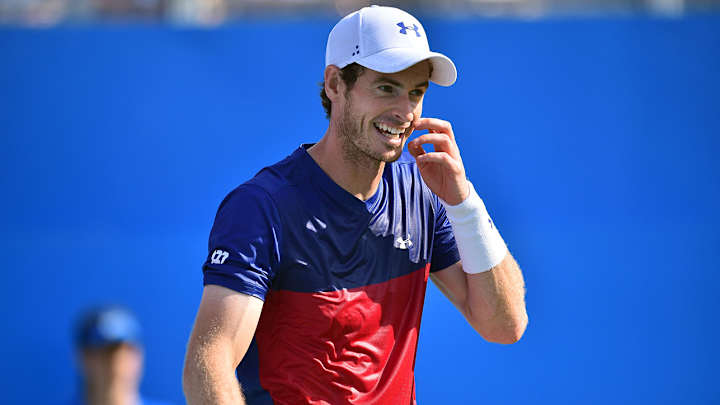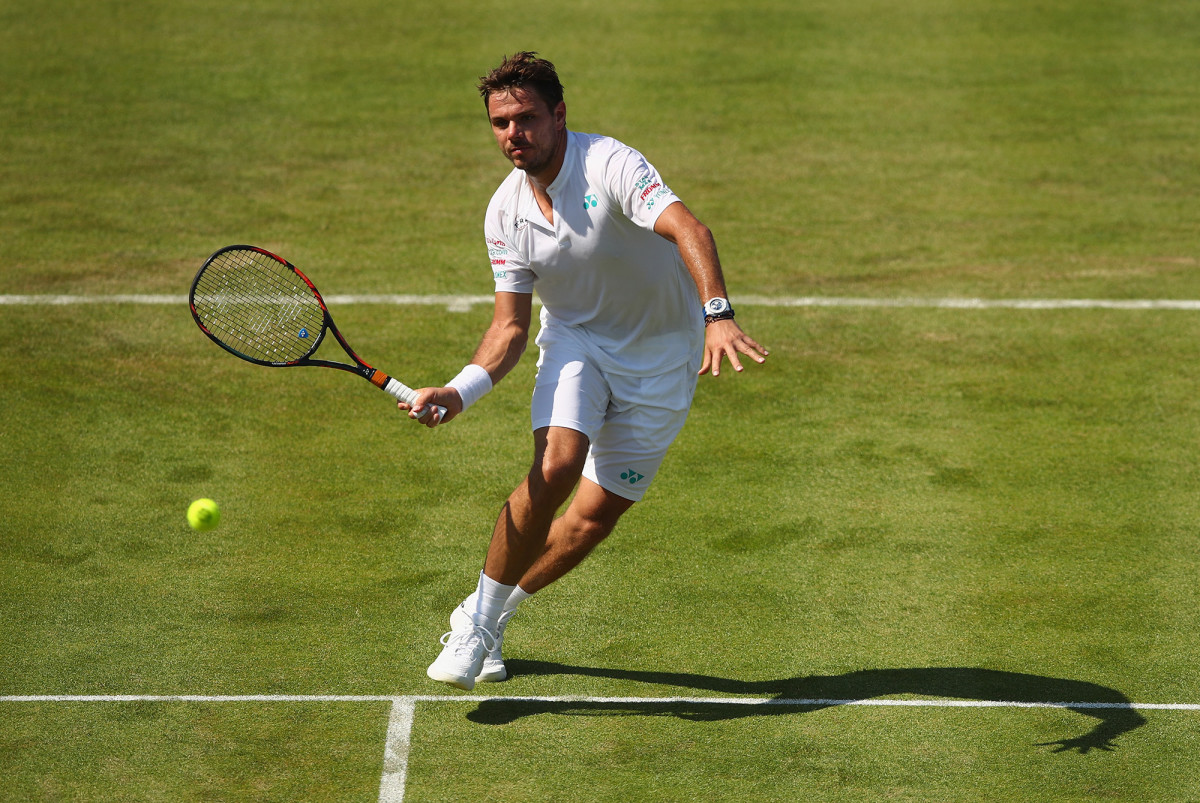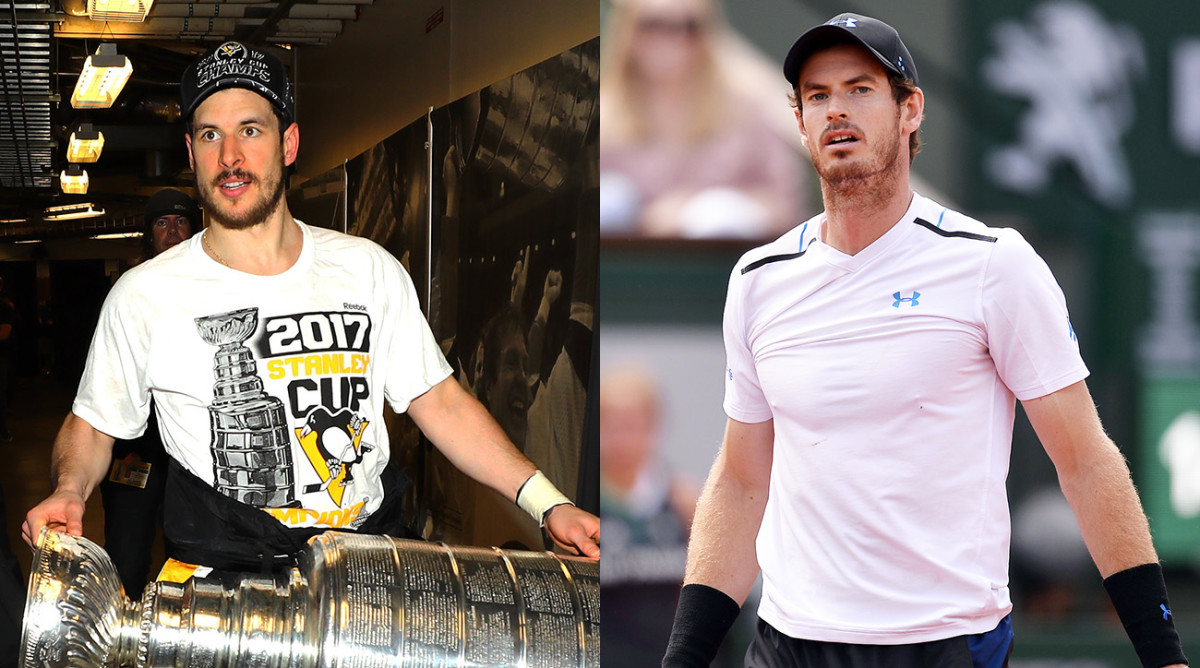Mailbag: The gap between Andy Murray's off-court class vs. on-court behavior

Some pre-Wimbledon chatter.
And we’ll play publicist now: Tennis Channel will be at Wimbledon first ball to last. We'll provide listing times next week.
Have a question or comment for Jon? Email him at jon_wertheim@yahoo.com or tweet him @jon_wertheim.
Mailbag
If there were a stat for gap between off-court class and on-court behavior, Murray would be No. 1.
—@truthintennis
• Absolutely. This has become a mild obsession of mine recently, but I am really interested in what happens to us during the aroused state of competition. As in other aroused states (go ahead: think sex) humans are prone to losing their minds. Our neurochemistry spikes. Both fight and flight reflexes intensify. Cool, dispassionate reason is elbowed out of the way by hot passion.
Different athletes handle this in different ways. Some throw tantrums. Some find balance in their routines (see: Nadal.) Some cry on the changeovers and even during play. Last week we saw Timea Babos, surely overcome with the stress of competition, declare that she wanted to throw the match. Murray has the curious habit of transferring his stress by yelling at his supporters.
Boris Becker declared bankrupt by British court
I once tried to discuss this with Andy Roddick. After a few attempts he said something to the effect of, “You just turn into a different person…you barely recognize yourself.” And, factually, he is correct. Two points: A) while players shouldn’t necessarily get a free pass, we ought to consider the brain chemistry that occurs under the stress of competition. B) we ought to draw a distinction between bad acts in competition and bad acts outside of competition. To me, the latter is much more serious and worthy of condemnation.
As for the reader’s point about Murray, I am in absolute agreement. Murray may have a few indecorous moments each match. (And if his camp kept a swear jar they would be eating steak dinner every night.) But once Murray’s match ends—and his brain chemistry returns to normal—you would be hard-pressed to find a more likable, collegial, intellectually curious athlete. And that ought to matter more. If nothing else, it sure beats the converse.
And this is why you don't skip clay, and stop all the momentum you had at the start of the year. Irony is he did this to prepare for grass, and now he is going to only get one match here. He better do well in Halle.
—Shlomo Kreitman
• Shlomo references Roger Federer, of course, who lost to Tommy Haas last week, in his first match since the Miami Open. Yes, Federer took a risk, removing himself from the clay season (and thus competitive tennis) for 10 weeks. But really, it’s all about Wimbledon. If he succeeds there—i.e. wins the title for the eighth time—he’ll look like a genius for adjusting his schedule so dramatically in order to peak for the grass. If he loses—especially betraying the rustiness he showed in Stuttgart—he’ll be subject to second-guessing. So it goes.
Look at it the other way, though. Imagine the second-guessing that would occur if he had played the French Open and, heaven forbid, injured himself. “You weren’t going to beat Nadal on clay, anyway. Now look what you’ve done. You’ve not only lost in Paris and lost your mental edge; you’ve compromised yourself before Wimbledon and the U.S. Open, the two Slams you had a much better chance of winning.”

Hi Jon. Stan has gone out in the first round of Queen’s Club again, having just reached the final of the French Open. While I appreciate several factors involved (change to grass, Lopez on good run of form, Stan's weakest surface etc.), it still reflects a wider pattern of Stan doing well at the Slams but poorly in smaller tournaments. My question is why do you think so many people find it charming, when in other sports a cup specialist who does poorly in the weekly grind would be criticized for lack of professionalism and shortage of motivation?
—Alex, London
• Easy on Stanislas! First there’s the surface. He’s won 36 matches and a title in Australia. 38 matches and title in France. 38 matches and a title at the U.S. Open…..at Wimbledon? He’s 18-12 and has never been beyond the quarters.
A few answers: 1) I don’t think it’s a question of charming or not charming. In individual sports, you eat what you kill. There are no guaranteed contracts. So it’s not as though a player who peaks for the big events is letting down his teammates or cheating or stealing from his employer. 2) If you have to peak, do it at the biggest events. You see players (should we pick on Elina Svitolina?) win title after title but then struggle when the stakes are highest, and you realize the alternative is preferable. 3) I wrote about this for Sports Illustrated next week but we are realizing that athletes are rational actors and are more accepting of decisions that maximize value and efficiency. If LeBron James’ ability to lead his team to the NBA Finals is predicated on his coasting through (generally meaningless) regular season games, so be it. If Serena Williams needs to take the fall off so as to ensure maximum health before Australia, so be it.
Mailbag: What's next for Novak Djokovic and his partnership with Andre Agassi?
Jon, I still say Buy (on weakness) for Novak Djokovic. I can actually see early round exits in Wimbledon and the U.S. Open but once he comes to grip with his domestic issues or whatever it is that is sapping his mental strength, he will win again. Unlike Tiger Woods, whose body has betrayed him as much as his psyche, Novak doesn't appear to have a significant injury. We've seen this too many times recently—Sampras, Agassi, Fed, Nadal. Remember how badly Apple's stock performed when Steve Jobs was turfed and now look at it. Novak could be that "stock.” Buying for a 2018 rebound! Are you rebalancing your portfolio?
—Neil Grammer, Toronto
• Totally agree. Buy on the dip. There is no apparent physical injury here. Thirty is no longer ancient in tennis. And you’re right: from Agassi to Sampras to Serena to Nadal to Federer, each has had a period—at least one—of infertility and then fecundity.
Why, after three years without a major, was Nadal so deliriously strong at the French Open? Lots of reasons. But high on the list: he was healthy. No knee pain. No wrist pain. No back issues. He had healed. With Djokovic, he, too, can heal. Whatever spiritual pain besets him, that, too, can be addressed and treated.
When assessing Nadal's Wimbledon record, don't you think we should consider that he is almost always coming off seven-straight matches at Roland Garros? Very few players ever complete the Wimbledon-French Slams back to back—not just because of the different surfaces, but because of the very short turn around. The guy barely has time to catch his breath or come down from the high. Given all that, I think it's a credit to Nadal that he's done as well as he has on the grass.
—Claire, Ottawa
• I see your point but you could just as easily argue that he has the good fortune of riding his confidence from France and getting the opportunity to play for another big prize. Pity the Australia winner—well don’t PITY them, per se; but consider their fate—who must wait four months before the opportunity to play another major.
Incidentally, I think it is relevant w/r/t Jelena Ostapenko. She wins the French Open. Yes, she gets feted back in Latvia and her phone blows up with texts. But I suspect it’s a disguised blessing that, after a week off, she must get back to preparing for another major.
Get to know 20-year-old surprise French Open champion Jelena Ostapenko
Thank you for the tips on visiting Roland Garros. I was awe-struck by how intimate the whole thing felt for such a large event. At times, I could literally reach out and touch tennis players as they were walking through the grounds. (I’m looking at you, Bethanie Mattek-Sands!) I was even lucky enough to see you walking the grounds, and gave you a, “Hey Jon!” both times as you passed. The tournament far exceeded my expectations, and I hope to go again someday. Thanks again.
—Kelly Wayne Gulley
• Yell louder next time!
Yes many share your impression. And the same goes for Wimbledon. For world-class, world-famous events, the grounds sure are modest in dimension. At both venues, you’ll often walk past even the most prominent players. Many of you—presumably male—have written about being “urinal adjacent” to players who are between sets. Anyway, I’ll be eager to see how Roland Garros balances its expansion and its innate charm.
When people pass on as Mr. Deford just has, it seems we have a small window of opportunity to remember them and I truly believe that SI should at the very least mention his remarkably moving book/memoir Alex: The Life of a Child. I read this book for the first time years ago and was so deeply touched that I wrote Mr. Deford to tell him so. Ten days later, I received a handwritten reply from that gracious man. When I heard he had died last week, I purchased another copy and am reading it again. It's still a book that wrenches ones heart with its honesty as he shares losing his daughter to CF.
Mr. Deford wrote everything with that same open honesty which is why I always was excited when I saw his name on anything in SI. Heck, I'd even read about hockey if he wrote it. There really was no one quite like him and as of today, there still isn't. I will miss him very much.
But that book....that book is a gift to anyone who has been through the death of a sickly child. It is a gift to a parent of a CF child. I am neither but I knew someone who lost a child to CF and I wish they could have found their grief with him.
He is gone but that book, though over 20 years old, should be brought up as we say goodbye to Mr. Deford. Not just because it deserves that but because it remains as true today as it was the day it was published. I know you make things happen. Please make this happen.
—Wendy Herrmann-Tross
• On a personal level, it’s been really heartening to see how much ink has been spilled (and pixels devoted) to memorializing and honoring Frank. In an era when shouting hot takes back and forth passes for journalism, it is reassuring to see that someone who trafficked in craft and style and nuance had such an impact.
I’ve been asked a lot of about Frank in recent weeks and what I’m most struck by is his versatility. We know about his towering long-form features. But that was hardly his only oeuvre. One colleague noted his fiction. Another his work on the movie “Everyone’s All-American.” A third wondered if knew that he was in the roller derby Hall of Fame? (I did not.) Hillary Clinton knew Deford not for his writing but for his Wednesday radio essays on NPR.
To the reader’s point, Frank and his wife lost their daughter to cystic fibrosis in 1980. He didn't just write a poignant book about his daughter; he became a spokesman in the fight against cystic fibrosis, raising tens of millions of dollars. Here’s an Amazon link.
Many commentators and, sometimes, even you, talk about the four major tournaments as “Slams.” It would seem to me that they should be called majors, for that is what they are. As for a slam, I'm not quite sure what that is. A Grand Slam, okay, but a Slam? What say you?
—Mike Willingham
• You’re right. The four biggest events ought to be known as majors. But “major” and “Slam” are now used interchangeably. To me, the critical distinction is “Slam” versus “Grand Slam.” Roger Federer won a Slam. Serena Williams won a Slam. Many, in fact. Neither won a Grand Slam, as Rod Laver and Steffi Graf did.
Shots, Miscellany
• The most recent SI / Tennis Channel podcast features Murphy Jensen, talking tennis, addiction and recovery.
• Next up: NCAA singles champion, Brienne Minor.
• The lovely, the talented Eric Butorac:
• Go home everyone. We have our point of the year.
Take a bow, gents 💥👌🎾
— Tennis TV (@TennisTV) June 19, 2017
@ThiemDomi and @maximarterer95 taking it to ANOTHER level!#GerryWeberOpen pic.twitter.com/on6psxO5Zl
• The United States Tennis Association today announced that renowned artist Peter Max has created the 2017 U.S. Open theme art, which celebrates the 20th anniversary of Arthur Ashe Stadium. Max also was commissioned to create the US Open theme art in 1997, which featured Arthur Ashe Stadium for the first time.
• Armed police to form Wimbledon ring of steel after terrorist attacks in London and Manchester.
• This week's LLS is from Bill: Sidney Crosby after winning the Stanley Cup with a playoff beard and hat and Andy Murray at Roland Garros with hat and facial hair.

